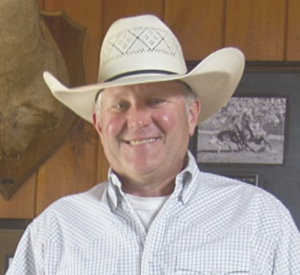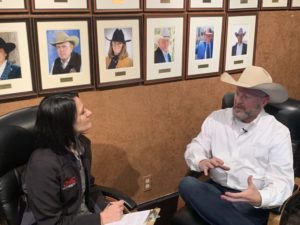
Jay Winborn NCHA Executive Director
You could say Jay Winborn is a man with a plan, or two or three. Not only is he brimming over with creative ideas, he has a track record of implementing them, successfully. It’s why the National Cutting Horse Association, plagued by membership decline, lack of leadership and financial strife, was prepared to make a lucrative offer to get Winborn on board. So in December of 2019, the NCHA welcomed Jay Winborn as the new executive director.
Winborn is credited with transforming the National Reined Cow Horse Association. In seven years as executive director, he doubled the membership, breathed new life into their events and increased spectator involvement. His resume also includes being a regional marketing manager for Red Bull, and a marketing director for Hatco.
The challenge of reversing the NCHA’s fortunes was a large part of what attracted Winborn to the job; that and his appreciation of cutting’s place in and contribution to Texas and the performance horse industry in general.
“I was approached a couple of times about coming over here [to the NCHA] and was a little reluctant because I had a good home at the Cow Horse…. but also got to the point where I felt that they were in really good shape. It’s important that cutting not die in this area.”
Winborn said there is a general decline in interest among all equine disciplines, not just cutting. But he said he is inspired by his memories of what cutting was in its hey-day.
“That made me very interested in coming over here, growing up in this area and being surrounded by my friends and counterparts that were involved in cutting. I remember what this Association once was and what it was like coming to the Futurity back in the 70s 80s and 90s,” he said.
“Those that were involved in it and the feeling you got when you came into the Will Rogers and you watch that and the people that came out and took part in that. I want to work real hard to recapture some of that.”
Winborn has a plan for how he is going to achieve that by rebuilding the membership numbers using some of the same strategies he employed at the NRCHA.
“Participation is huge” he said. “We doubled our membership [in the NRCHA] my first year in 2013 and we got pretty aggressive about membership drives and getting people involved.”
Winborn took a unique approach. A lot of organizations would try to attract totally ‘green’ people to get involved in horses, but Winborn said it’s too hard a sell.
“I specifically pointed my marketing efforts and my promotion efforts to people that were already in the industry in some aspects. Perfect example, High School Rodeo. When we got cow horse in the High School Rodeo, I knew that kids and parents are already comfortable owning horses, hauling, having a trailer and tack, trainers and everything that goes along with [showing horses].”
Winborn said it’s a lot smaller step for a horse owner to switch disciplines than get someone totally new to the sport to look for a horse, trainer, buy lessons and all the equipment. He said the key is figuring out how to open the sport to a wider audience and give people a feel of the thrill of riding a cutting horse.
“The cutting, I think is more user-friendly than the cow horse. I don’t want to say it’s easier, but the proficiency level is a lot easier for someone to get started on a cutter than it is going down the fence, reining and cutting combined,” he said.
Social media was another important strategy in building membership at the NRCHA that he also plans to replicate and improve upon at the NCHA.
“I don’t think the marketing and sponsorship departments here have had a lot of direction in the past…I approach things with kind of a new mindset and I believe this history as a whole the performance horse industry is pretty antiquated and the way they go to market with these with these associations…I think you still need to maintain that but there needs to be additional fortifications that come in that touch various different audiences,” he said.
When used effectively, Winborn said social media can reach people cutting is not talking to right now. It can showcase the sport and get people excited and involved.
“When I had taken over the Cow Horse, they pretty much had gone stagnant with any promotion whatsoever. And we came in pretty much with a shotgun approach and were able to draw a lot of eyes on us,” he added.
Drawing new people in is one thing, keeping them is another. Winborn said friendliness and support is essential to winning people over. It was a culture the NRCHA fostered

Simone interviewing Jay Winborn
successfully.
“We had a welcoming membership that when somebody new came in, we took him under our arm and that’s a mindset we’re going to have to develop here and I want to work hard to kind of kind of nurture that [in cutting] because I can bring two thousand people here that are ready to go, but If they don’t feel good about it, they’re not going to stick around,” Winborn said.
Another big initiative for Winborn is to grow youth involvement to ensure the sport’s longevity. Cutting is very top loaded with people aged over 50. While there is an active youth group, membership is sparse among young adults to middle aged riders who are busy with their careers and family and don’t have the time or money to show.
“The important part is that we do get them back. This is where you want them instead of buying golf clubs or a boat. You want them coming back to this.” He added that a lot of empty nesters, who used to show or ride, want to enjoy horses again. If cutters can make that impression on people when they are young, Winborn believes there’s a good chance they’ll return to it.
“One thing I learned at Red Bull is a majority of your habits are formed between 13 and 23 years old, your lifelong habits. So if that is your world, it’s kind of what you drift back to as you get older and we capture that moment in those kids lives to really make an impact,” he said.
We continue Part 2 on Jay Winborn next month!
Brought to you by Kyle Zanetti